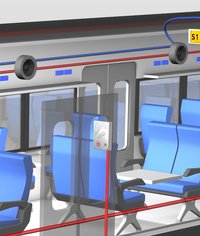
The central acoustic system is also part of the modular VisiWeb PIS system. The acoustic computer communicates closely with the on-board computer; it has access to the central announcement database and the compressed MP3 audio data stored there inside the on-board computer system.
The central acoustic system is also part of the modular VisiWeb PIS system. The acoustic computer communicates closely with the on-board computer; it has access to the central announcement database and the compressed MP3 audio data stored there inside the on-board computer system.
The acoustic computer uses the MP3 fragments to compile individual announcements and streams these digitally to the power amplifiers which make the power signals for the interior and exterior loudspeakers available based on 100 V or low-ohm technology. At the same time the acoustic computer manages the specific acoustic signals (conductors 1...8) of the UIC 558/568 cabling throughout the train, and ensures compatibility with coupled vehicles which comply with the UIC 558/568 code (or one of its many derivatives).
Spontaneous announcements can be made via any VisiWeb control panel in driver's cabs or any conductor station. These spontaneous announcements can be streamed in the vehicles either encoded as VoIP over the PIS Ethernet or in analog format via the UIC cabling. Thanks to a separate auxiliary voltage supply, even in the event of the failure of all other PIS components, the acoustic system can continue to be used by the driver to issue spontaneous announcements or by passengers to make calls for help.
The announcement application primarily supports the following functions:
- Announcement of the current stop, next stop, line and destination, safety information
- Spontaneous announcements (programmed or spoken locally)
- Forwarding of all announcements to all interior and exterior loudspeakers, monitor loudspeakers in cabs and conductor stations
- Forwarding of announcements from the control centre, conductor stations, exterior loudspeakers and/or passenger compartments
- Selective connection of groups of loudspeakers
- Volume control based on prevailing noise levels (compartment-specific and time-specific)
- Selective frequency correction
- Project-specific processing of all prioritization signals in the vehicle
- Coordination with possible entertainment sound level

